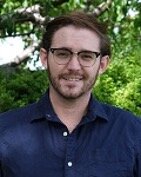By Nicole Wakeland
Matthew Limb is a UCSB History of Art and Architecture graduate student who was awarded The Henry Luce Foundation/ACLS Dissertation Fellowship in 2020.
Links between crafts and land use within the American West prompted an environmental awakening among Californian artists during the 1960s that remains an unwritten chapter of the environmental art movement, says Matthew Limb, a sixth-year Ph.D. candidate and Doctoral Scholars Fellow at UC Santa Barbara.
During this time, artists began using natural materials for craft production as a way to financially support themselves, which encouraged social awareness and ethical methods of creating art.
Limb has received numerous grants and honors throughout his time at UCSB, including The Henry Luce Foundation/American Council of Learned Societies Dissertation Fellowship in American art in 2020. This prestigious fellowship supports dissertation research and writing on topics relating to American art, and awards only 10 grants nationally, giving recipients a $38,000 stipend for one year.
“There’s a really rich conversation going on about land use, art and Native Americans that has been the focus for my dissertation and what I’ve been working on this year,” says Matthew Limb, sixth-year Ph.D. candidate and Doctoral Scholars Fellow at UCSB.
Limb’s dissertation, Living on the Edge: Ceramics and the Environment in the American West, 1961-2000, examines the overlap of craft production and the environmental movement within the United States. Limb writes about artists who harvested materials to use in their art such as clay, metals, sand, fibers, and wood.
In a recent interview, Limb discussed the central ideas of his dissertation, how his interest in art history developed, and his upcoming plans.
Q: Can you tell me more about this connection between craft and land use that is such a central idea in your dissertation?
A: When we’re talking about American craft made of materials like textiles, ceramics, metals, glass, fibers, and woodwork, they all have a very direct connection to the land and to the earth. Oftentimes, craftspeople will harvest their own materials; and I was really interested in this connection between the artist and the landscape. We start to see a very large environmental consciousness develop within artists in California within the 1960s who are interested in making people more ethical, empathetic users of everyday life. If we’re thinking about things like global warming and climate change, how can art help in this conversation and how is its own processes implicated in that?
Q: When and how did you first find an interest in art?
A: I never intended to study art and was never interested in art. But as an undergrad, I was a history major and I found very quickly that my historical interests were moving towards visual and material culture. It was during my Ph.D. program that I really found a home within the art world. It’s a very rich field for telling stories, which is really what I want to do.
Q: What have you been working on since receiving The Henry Luce Foundation/ACLS Dissertation Fellowship?
A: The pandemic really changed things for my work this year, so I had to think very creatively about this project and consider what information is available to me through the internet or through digital archives. I was very fortunate to make connections with archives at the Stanford University Library and at the Center for Environmental Design Research at UC Berkeley which holds some of the primary papers for artists I’m working on. Through that, I’ve been working on a couple of different chapters that are very California focused which explore land use, art, and Native Americans.
Q: What are your plans for the future here at UCSB or after graduating?
A: I have been incredibly lucky in the external fellowships I have been able to secure for myself, and I’m actually moving to Washington D.C. for a fellowship I have next year at the Smithsonian American Art Museum. The plan is to finish my dissertation there and start looking for jobs, but my end goal is to teach and do research at a university. I would love to end up back in California since my research is largely about California and the American West.
Nicole Wakeland is a third-year communications major at UC Santa Barbara who is also pursuing a professional writing minor. She wrote this article for her Writing Program class, Journalism for Web and Social Media.



